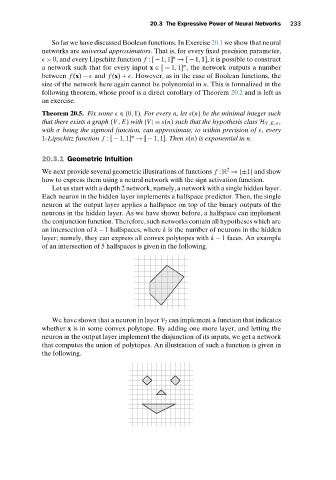Page 251 - Understanding Machine Learning
P. 251
20. 3 The Expressive Power of N eura l N etworks 233
So far we have discussed Boolean functions. In Exercise 20.1 we show that neural
networks are universal approximators. That is, for every fixed precision parameter,
n
> 0, and every Lipschitz function f : [−1,1] → [−1,1], it is possible to construct
n
a network such that for every input x ∈ [ − 1,1] , the network outputs a number
between f (x) −
and f (x) +
. However, as in the case of Boolean functions, the
size of the network here again cannot be polynomial in n. This is formalized in the
following theorem, whose proof is a direct corollary of Theorem 20.2 and is left as
an exercise.
Theorem 20.5. Fix some
∈ (0,1). For every n,let s(n) be the minimal integer such
that there exists a graph (V , E) with |V |= s(n) such that the hypothesis class H V ,E,σ ,
with σ being the sigmoid function, can approximate, to within precision of
,every
n
1-Lipschitz function f :[ − 1,1] → [ − 1,1].Then s(n) is exponential in n.
20.3.1 Geometric Intuition
2
We next provide several geometric illustrations of functions f : R →{±1} and show
how to express them using a neural network with the sign activation function.
Let us start with a depth 2 network, namely, a network with a single hidden layer.
Each neuron in the hidden layer implements a halfspace predictor. Then, the single
neuron at the output layer applies a halfspace on top of the binary outputs of the
neurons in the hidden layer. As we have shown before, a halfspace can implement
the conjunction function. Therefore, such networks contain all hypotheses which are
an intersection of k − 1 halfspaces, where k is the number of neurons in the hidden
layer; namely, they can express all convex polytopes with k − 1 faces. An example
of an intersection of 5 halfspaces is given in the following.
We have shown that a neuron in layer V 2 can implement a function that indicates
whether x is in some convex polytope. By adding one more layer, and letting the
neuron in the output layer implement the disjunction of its inputs, we get a network
that computes the union of polytopes. An illustration of such a function is given in
the following.

